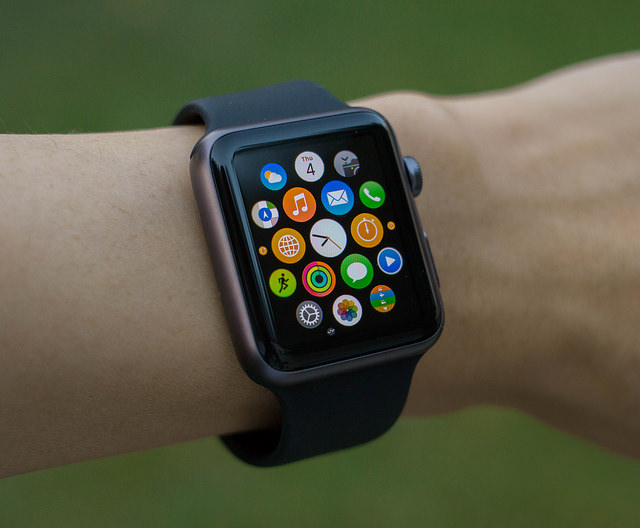For just under a week, an Apple Watch has been on my wrist. I went for the “nerd” choice, a Space Grey watch with a black rubber band. For most of the day, the watch appears to be an obsidian lozenge — a black hole of information. But, now and then, when I want to check the time, or when it taps me gently on the wrist to remind me of something, I turn my wrist towards my face, and the screen comes to life with the snippet of information I need to keep my life running, well, like a really expensive timepiece.
And, for now, the Apple Watch is expensive. This model is just under $600 in Canada, all in. I consider it the tax I pay for wanting to live in the future. But, for the money, you get a lot of watch. In fact, the Apple Watch is a wristwatch the same way a smartphone is a telephone. Both are computers disguised as less functional appliances. The Apple Watch, all smartwatches, really, extend the basic functionality of a watch dramatically. They give you glanceable information on demand on your wrist. But that information is remarkable.
So far my watch has told me my heart rate, my race pace, the weather, when the next GO bus is due, that tea is steeped, that the International Space Station is overhead and has served up a very readable Wikipedia entry about Frank Sinatra. I‘ve also used it to check my schedule, triage my email and send myself reminders and to-dos. And, yes, I can take and make phone calls and get the time.
The Watch is capable of most, but not all, of this because it is near my phone. And, yes, I could do all those things above with my phone. But, dismissing the Watch because of that is the act of a technologically myopic simpleton.
In many ways smartwatches as they exist now are proofs of concept. Of course, in the very near future, smartwatches will be stand-alone devices. But, for now, they are remarkable in their own, dependent way.
For one thing, they redefine the interstitial moment. With a smartphone that moment lasted as long as it took to pull your phone from your purse or pocket, fire up the app you needed and scroll through a digestible information snack.
With the Watch, a wrist tap tells you there’s something you need to pay attention to. You turn your wrist to your face, the information appears, you give it a quick look, and you’re done in about a heartbeat or two. If it’s a text or email you can save it for later or respond with a quick prefab reply or even dictate text to the Watch and have it, very reliably in my experience, convert to text for sending. It is delightful to deal with incoming information so effortlessly without breaking social stride.
News organizations or any group that wants to get news and messaging out needs to pay attention to being “smartwatch-first” now.
The Watch is not, of course, perfect. Existing third-party apps can run maddeningly slow and the Watch sometimes stalls waiting for updated data, but many of those annoyances will pass when developers create native Watch apps and future Watches get GPS and other radios on board.
Apple announced Watch-native app support, literally, as I was typing this. I added this paragraph by speaking it to my Watch using the Drafts app while watching this week’s Apple keynote.
What most excites me about the Watch right now is not what it is, but what it could be. It will be cheaper, faster and more fully featured soon. It will have tremendous importance to health care, fitness and social media. In the near future all phones will be smartphones. And, I have no doubt, all watches will be smartwatches. But, for now, the only people who need to get one are those who want to wear the future on their sleeves.
Listen to an audio version of this column, read by the author, here.
Wayne MacPhail has been a print and online journalist for 25 years, and is a long-time writer for rabble.ca on technology and the Internet.
Photo: LWYang/flickr




